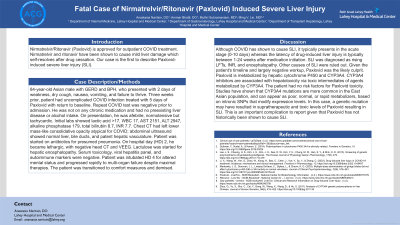Sunday Poster Session
Category: Liver
P1063 - Fatal Case of Nirmatrelvir/Ritonavir Induced Severe Liver Injury
Sunday, October 22, 2023
3:30 PM - 7:00 PM PT
Location: Exhibit Hall

Has Audio

Anastasia Naritsin, DO
Lahey Hospital and Medical Center
Woburn, MA
Presenting Author(s)
Anastasia Naritsin, DO1, Ammar Bhatti, DO1, Mythri Subramaniam, MD2, Ming V. Lin, MD1
1Lahey Hospital and Medical Center, Burlington, MA; 2Lahey Hospital, Burlington, MA
Introduction: Nirmatrelvir/Ritonavir (Paxlovid) is approved for outpatient COVID treatment. Nirmatrelvir and ritonavir have been shown to cause mild liver damage which self-resolves after drug cessation. Our case is the first to describe Paxlovid-induced severe liver injury (SLI).
Case Description/Methods: 84-year-old Asian male with GERD and BPH, who presented with 2 days of weakness, dry cough, nausea, vomiting, and failure to thrive. Three weeks prior, patient had uncomplicated COVID infection treated with 5 days of Paxlovid with return to baseline. Repeat COVID test was negative prior to admission. He was not on any chronic medication and had no preexisting liver disease or alcohol intake. On presentation, he was afebrile, normotensive but tachycardic. Initial labs showed lactic acid >17, WBC 17, AST 2151, ALT 2947, alkaline phosphatase 179, total bilirubin 8.7, INR 7.7. Chest CT had left lower mass-like consolidative opacity atypical for COVID; abdominal ultrasound showed normal liver, bile ducts, and patent hepatic vasculature. Patient was started on antibiotics for presumed pneumonia. On hospital day (HD) 2, he became lethargic, with negative head CT and VEEG. Lactulose was started for hepatic encephalopathy. Serum toxicology, viral hepatitis panel, and autoimmune markers were negative. Patient was intubated HD 4 for altered mental status and progressed rapidly to multi-organ failure despite maximal therapies. The patient was transitioned to comfort measures and demised.
Discussion: Although COVID has shown to cause SLI, it typically presents in the acute stage (0-10 days) whereas the latency of drug-induced liver injury is typically between 1-24 weeks after medication initiation. SLI was diagnosed as rising LFTs, INR, and encephalopathy. Other causes of SLI were ruled out. Given the patient's timeline and largely negative workup, Paxlovid was the likely culprit. Paxlovid is metabolized by hepatic cytochrome P450 and CYP3A4. CYP3A4 inhibitors are associated with hepatotoxicity via toxic intermediates of agents metabolized by CYP3A4. The patient had no risk factors for Paxlovid toxicity. Studies have shown that CYP3A4 mutations are more common in the East Asian population, and can appear as poor, normal, or rapid metabolizers, based on intronic SNPs that modify expression levels. In this case, a genetic mutation may have resulted in supratherapeutic and toxic levels of Paxlovid resulting in SLI. This is an important complication to report given that Paxlovid has not historically been shown to cause SLI.
Disclosures:
Anastasia Naritsin, DO1, Ammar Bhatti, DO1, Mythri Subramaniam, MD2, Ming V. Lin, MD1. P1063 - Fatal Case of Nirmatrelvir/Ritonavir Induced Severe Liver Injury, ACG 2023 Annual Scientific Meeting Abstracts. Vancouver, BC, Canada: American College of Gastroenterology.
1Lahey Hospital and Medical Center, Burlington, MA; 2Lahey Hospital, Burlington, MA
Introduction: Nirmatrelvir/Ritonavir (Paxlovid) is approved for outpatient COVID treatment. Nirmatrelvir and ritonavir have been shown to cause mild liver damage which self-resolves after drug cessation. Our case is the first to describe Paxlovid-induced severe liver injury (SLI).
Case Description/Methods: 84-year-old Asian male with GERD and BPH, who presented with 2 days of weakness, dry cough, nausea, vomiting, and failure to thrive. Three weeks prior, patient had uncomplicated COVID infection treated with 5 days of Paxlovid with return to baseline. Repeat COVID test was negative prior to admission. He was not on any chronic medication and had no preexisting liver disease or alcohol intake. On presentation, he was afebrile, normotensive but tachycardic. Initial labs showed lactic acid >17, WBC 17, AST 2151, ALT 2947, alkaline phosphatase 179, total bilirubin 8.7, INR 7.7. Chest CT had left lower mass-like consolidative opacity atypical for COVID; abdominal ultrasound showed normal liver, bile ducts, and patent hepatic vasculature. Patient was started on antibiotics for presumed pneumonia. On hospital day (HD) 2, he became lethargic, with negative head CT and VEEG. Lactulose was started for hepatic encephalopathy. Serum toxicology, viral hepatitis panel, and autoimmune markers were negative. Patient was intubated HD 4 for altered mental status and progressed rapidly to multi-organ failure despite maximal therapies. The patient was transitioned to comfort measures and demised.
Discussion: Although COVID has shown to cause SLI, it typically presents in the acute stage (0-10 days) whereas the latency of drug-induced liver injury is typically between 1-24 weeks after medication initiation. SLI was diagnosed as rising LFTs, INR, and encephalopathy. Other causes of SLI were ruled out. Given the patient's timeline and largely negative workup, Paxlovid was the likely culprit. Paxlovid is metabolized by hepatic cytochrome P450 and CYP3A4. CYP3A4 inhibitors are associated with hepatotoxicity via toxic intermediates of agents metabolized by CYP3A4. The patient had no risk factors for Paxlovid toxicity. Studies have shown that CYP3A4 mutations are more common in the East Asian population, and can appear as poor, normal, or rapid metabolizers, based on intronic SNPs that modify expression levels. In this case, a genetic mutation may have resulted in supratherapeutic and toxic levels of Paxlovid resulting in SLI. This is an important complication to report given that Paxlovid has not historically been shown to cause SLI.
Disclosures:
Anastasia Naritsin indicated no relevant financial relationships.
Ammar Bhatti indicated no relevant financial relationships.
Mythri Subramaniam indicated no relevant financial relationships.
Ming Lin indicated no relevant financial relationships.
Anastasia Naritsin, DO1, Ammar Bhatti, DO1, Mythri Subramaniam, MD2, Ming V. Lin, MD1. P1063 - Fatal Case of Nirmatrelvir/Ritonavir Induced Severe Liver Injury, ACG 2023 Annual Scientific Meeting Abstracts. Vancouver, BC, Canada: American College of Gastroenterology.
